PinotFile: 8.25 November 7, 2010
|
Revisiting New Zealand Pinot NoirIn 2008, I presented an extensive review of New Zealand Pinot Noir in the PinotFile titled, “Finicky Pinot Noir Thriving in Middle Earth,” (www.princeofpinot.com/article/539/). That article followed my travel to New Zealand in 2008 and the wines reviewed were from the 2003 to 2006 vintages. I found the wines to be inconsistent, but a handful of exported Pinot Noirs were capable of a world class drinking experience. The styles varied but the Pinot Noirs veered more toward New World flashiness than Burgundian restraint. I felt California’s value priced Pinot Noirs were generally superior to those from New Zealand despite the claims of wine writer Matthew Jukes who has said, “New Zealand can claim to make the best good-value Pinot in the world.” The 2008 New Zealand Pinot Noirs have been arriving in the stateside retail market in recent months and I decided to take another look at the quality of the wines being exported. The 2008 vintage was an excellent one in Martinborough and Central Otago, but was marred by rains in Marlborough. The grape harvest in 2008 ballooned to 280,000 tons, a 39% increase above 2007 due to excellent flowering and a favorable growing season along with an increasing number of areas coming into production. This increase in production and the global recession has caused concerns about oversupply as inventories accumulate of premium New Zealand wines from past vintages. As in the United States, premium New Zealand Pinot Noir sales have faltered. New Zealand is about the size of Oregon, and despite the relative infancy of its modern wine history, its planted Pinot Noir acreage surpassed Oregon in 2009 (11,619 acres to 11,523). Pinot Noir now makes up 15% of New Zealand’s total vineyard plantings, second only to Sauvignon Blanc and is New Zealand’s second most exported variety. The two biggest export markets for New Zealand are Australia and the UK, but it is projected that the United States eventually will become the number one export market for New Zealand wines. In 2008, New Zealand wine exports were worth $797.8 million, a 14 percent increase over 2007 and a significant increase from the $60 million the industry exported just over a decade earlier. The modern Pinot Noir winegrowing industry in New Zealand dates to the mid 1970s beginning with experimental plantings of Rolfe and Lis Mills of Rippon Vineyard on the banks of Lake Wanaka in the Central Otago region of the South Island of New Zealand, and concurrently, Nobilo Vintners in Auckland on the North Island. The wine industry has shown remarkable growth reaching 643 wineries by 2009, varying in size from small boutique operations producing a few thousand cases to huge conglomerates with annual sales exceeding two million liters. 85% of New Zealand wineries are foreign-owned. Geographically, New Zealand has both a North Island and South Island as shown on the New Zealand Winegrowers map on Page 2. The latitudes of 36 to 45 degrees allow wine grapes to be grown throughout both islands except on the cold west coast and pocketed frigid areas. All the major grape growing regions have a maritime climate except Central Otago which is the only viticulture area blessed with a continental weather pattern. There are ten wine regions, but only half have major plantings of Pinot Noir (2009 total acreage is given in parentheses). The Wairarapa on the southeastern tip of the North Island includes multiple sub-regions including well-known Martinborough (2,123 acres). Nelson is located in the north-central part of the South Island and 25% of the vineyards are planted to Pinot Noir (452 acres). Marlborough, in the northeastern corner of the South Island, has the largest and most recognizable wineries, the largest plantings of Pinot Noir, and the largest production of inexpensive Pinot Noirs (4,942 acres). Waipara is a subregion in the northern part of Canterbury along the coast of the South Island south of Marlborough (769 acres). Central Otago is the most southerly wine region in New Zealand known for its spectacular scenery. 60% of the vineyards are planted to Pinot Noir (2,970 acres).
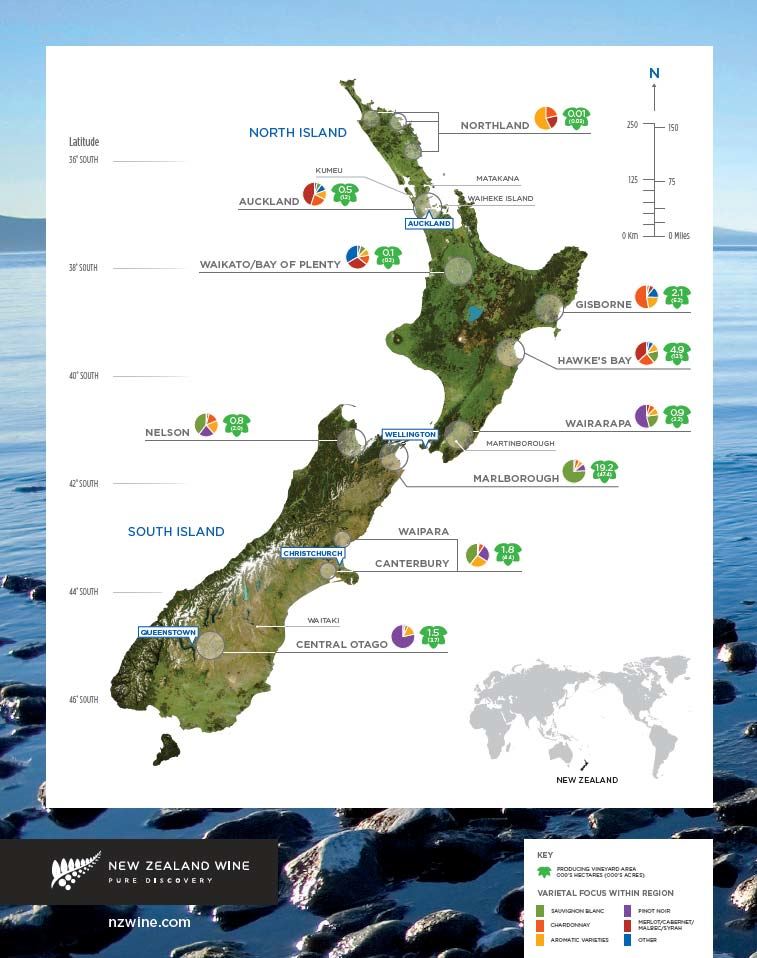 Early plantings of Pinot Noir in New Zealand were primarily Pommard 5, UCD 10/5 (a clone imported to New Zealand in the 1960s from Wädenswil Research Station in Switzerland by government viticulturist Frank Berrysmith), and UCD 2/10. Later UCD 6 and 13 were added and in the early 1990s, the New Zealand government released the Dijon clones including 113, 114, 115, 667, 777 and 375. There are suitcase clones in the ground as well. Phylloxera has surfaced in New Zealand but is not a significant problem yet. Spread is very slow and there is constant replanting and new planting of Pinot Noir vines on resistant rootstock. The viticulture scheme here has always encouraged non-irrigated vines and organic farming. A code of sustainable practices, Sustainable Winegrowing New Zealand, was developed in 2002. Soils are primarily alluvial throughout the country, with some pockets of limestone. The New Zealanders pioneered the use of screw cap closures and since 2001 practically every winery uses them exclusively for white wines, and all reds except the ultra-premium bottlings which are shipped to the United States with corks to avoid the cheap image that screw-capped wines still have among wine enthusiasts here. There has also been experimentation with Diam agglomerate cork but I did not see this closure on any of the bottlings I sampled recently. It has been difficult to define a distinctive style for New Zealand Pinot Noir as there are vast differences in microclimates, viticulture and winemaking throughout the two islands. Vintage differences play a significant role in New Zealand as well. Like California and Oregon, there are stylistic extremes varying from elegant, restrained and classic Pinot Noirs, to heavily extracted and generously oaked fruit bombs. Bennett Traub has claimed New Zealand Pinot Noir falls in the middle ground between New World flashiness and Burgundian restraint. He says, “They fit stylistically between the riper, more opulent style of Pinot Noir of top wines from Sonoma, Mendocino and Oregon, and the classic, terroir-focused wines from Burgundy.” Geoff Kelly, writing recently in The World of Fine Wine (Issue 28 2010), points out the criticism that has plagued New Zealand Pinot Noir. I agree with him that the Pinot Noirs often lack textural quality, complexity of aroma and flavor and an expression of place. The may show a floral, leafy quality due to under-ripeness while others are overripe with black plummy flavors. Excessive oak and moderately high alcohol show up as well, although alcohols generally are less than California. That said, the wines have plenty of fruit weight with good color and bright acidity, and are consistently reliable. Age ability parallels California and Oregon Pinot Noir with most premium wines drinking at their prime three to six years after release. The Pinot Noirs from the two major Pinot Noir producing regions, Martinborough and Central Otago due show differences. The wines from Martinborough tend to have more color and sturdier tannins, sometimes displaying a subtle gaminess, and have lower total acidity. The Pinot Noirs from Central Otago, in contrast, display more vibrant fruit and flamboyance with some of the best wines offering delicacy and subtlety. There are a handful of stellar producers in New Zealand and many export their wines to the United States. Some of the top bottlings from these and other wineries are not exported. Plenty of inexpensive Pinot Noir from Marlborough is exported and available on supermarket shelves, and these wines, although direct, cheap and supply a satisfactory daily drinking experience, give a skewed and desultory impression of what New Zealand Pinot Noir can be. The value-priced New Zealand Pinot Noirs find it challenging to compete with similar wines in California and Oregon, especially since a number of quality stateside producers are now releasing second labels that are priced around $25. As in the United States, Pinot Noir from New Zealand may not always be 100% Pinot Noir in the value-priced category. In New Zealand, since 2006, 85% of the wine must be from the variety, vintage or area on the label (In the United States, at least 75% of the volume of the wine must be composed of the designated grape variety). Tim Atkin MW, one of Great Britain’s most respected wine writers, recently listed twenty-five world-class New Zealand producers of Pinot Noir (The World of Fine Wine Issue 27 2010): Ata Rangi, Bald Hills, Bell Hill, Burnt Spur, Churton, Craggy Range, Escarpment, Felton Road, Gibbston Valley, Grasshopper Rock, Julicher Estate, Martinborough Vineyards, Ma Maison, Mount Difficulty, Mount Edward, Neudorf, Pegasus Bay, Pyramid Valley, Quartz Reef, Rippon, Schubert, Seresin Estate, Two Paddocks, Valli, and Wooing Tree. Most of these producers export to the United States and are available from several sources (Sherry-Lehman, JJ Buckley, Hi- Time Cellars, K&L Wines, Southern Wines, and others). Check www.wine-release.com for retailers. During the past year I reviewed impressive offerings from Alana Estate, Rippon, and Seresin Estate. All the following reviewed wines are currently available in the United States. They are organized according to region of origin. Prices for premium New Zealand Pinot Noirs are comparable to those from California and Oregon. New Zealand Pinot Noir remains a niche market and a novelty in the United States, but will appeal to pinoaficionados with varied and international interests.
The first vineyards were planted in Martinborough in 1978 by Alistair Taylor at about the same time that a report by Derek Milne was published identifying the stony terraces around the town of Martinborough as ideal for viticulture. By the early 1980s, the area had five mainstay wineries: Ata Rangi, Te Kairanga, Chifney, Dry River and Martinborough Vineyard. The second wave of wineries arrived in the late 1980s including Palliser Estate, and the third wave followed in the 1990s with the arrival of Escarpment and Craggy Range Vineyards at Te Muna.
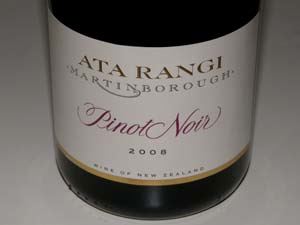 2008 Ata Rangi Martinborough New Zealand Pinot Noir 13.5% alcohol, $45, screw cap. Imported by Epic Wines, Aptos, CA. · Very shy aromas of darker berry fruit with hints of oak and green garden. Tasty attack of earth-kissed dark red cherries and berries which persist on the fruit-driven and uplifting finish. Nicely balanced and silky textured. Still closed and will benefit from a few years in the cellar. Very good.
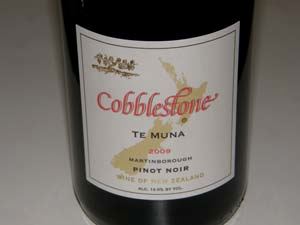 2009 Cobblestone Te Muna Martinborough New Zealand Pinot Noir 14.9% alc., 694 cases, $60 (but available in the US at half that price). Imported by Cobblestone Vineyards, Napa, CA. From a vineyard on Te Muna Road. Inaugural wine from this producer that was awarded the “Wine of Show” trophy at the 2010 Romeo Bragato Wine Awards in New Zealand. · Moderate reddish purple color in the glass. The nose is shy with demure berry fruit, sandalwood and a hint of mint. Big-boned core of tasty dark red fruits balanced by healthy tannins and bright acidity producing a grapefruit-tinged finish. Picks up interest with time in the glass and shows admirable persistence on the bright finish. The high alcohol is well-integrated. Good.
2008 Craggy Range Kidnapper’s Vineyard Martinborough New Zealand Chardonnay 13.5% alc., $17. Imported by Kobrand Corp, NY, NY. The 2008 vintage was stellar for Chardonnay in New Zealand. · Very light straw color. Pleasingly clean aromas of white peaches and citrus. Discreetly rich flavors of white stone fruits and apples with a citric peel lift on the refreshing finish. Good (+).
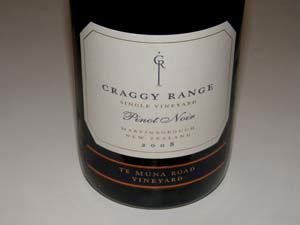 2008 Craggy Range Te Muna Road Vineyard Martinborough New Zealand Pinot Noir 13.5% alc., $33. Imported by Kobrand Corp, NY, NY. Vineyard planted to 8 clones in more than 40 different parcels. Indigenous yeast fermentation, aging for 1 year in French oak barrels without racking. Moderately dark reddish-purple color in the glass. · Complex nose offering scents of black cherries, strawberries, sandalwood, and dried herbs including sage. Very tasty essence of dark red cherries and berries with noticeable persistence of cherry flavors on the generous finish. A very subtle green note and hint of tobacco and mushroom peeks out. Softly textured and very smooth in the mouth and very approachable now. Very good.
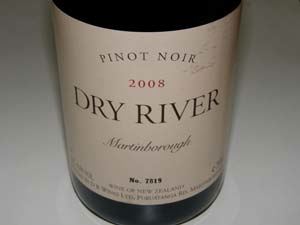 2008 Dry River Martinborough New Zealand Pinot Noir 12.5% alc., $95, long neck bottle. Imported RO Imports LLC, Napa, CA. · Moderately deep reddish-purple hue in the glass. Amazingly vivid array of dark fruit aromas including hi-tone raspberry with nuances of tea and dried rose petals. Delicious and well-mannered complex of cherry and berry flavors with a very subtle leafy note. Seamless and seductive with flavors that caress the mouth and fan out beautifully on the lush and generous finish. More elegant and approachable than some vintages of this wine. One of the world’s greatest Pinot Noirs and one of the most spellbinding Pinot Noirs I have sampled this year.
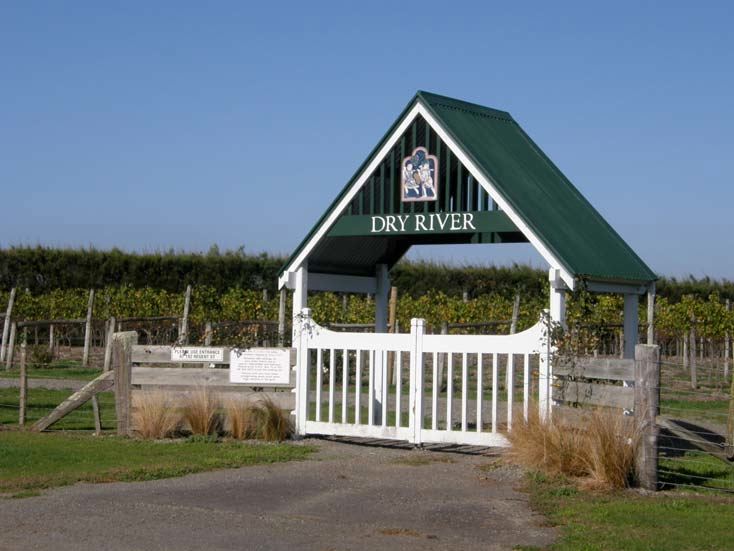
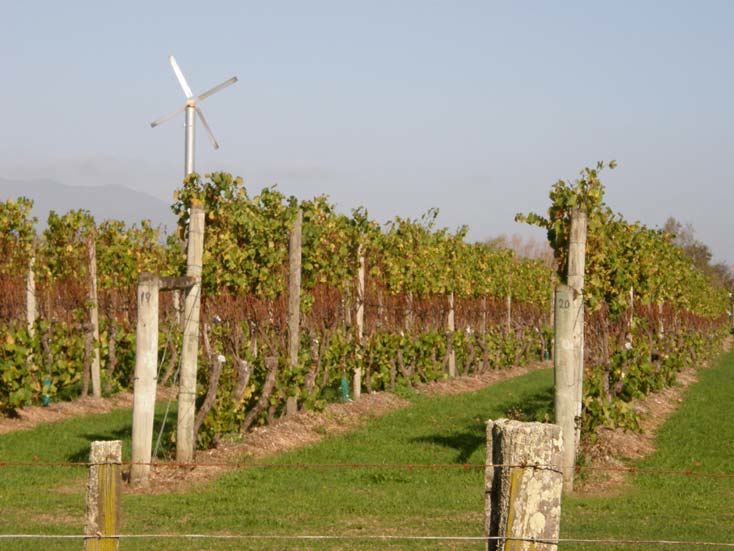
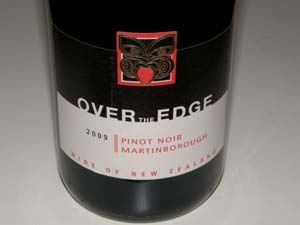 2008 Over The Edge Martinborough New Zealand Pinot Noir 14.5% alc., $13, screw cap. Imported by Meadowbank Estates, Alexandria, VA. Second label of Escarpment. Winemaker Larry McKenna. · Medium reddish-purple color in the glass. Deep and intense aromas of black cherries, black raspberries and plum sauce. Delicious core of darker fruits including black currents. Full-bodied and Caliesque in style but with restrained tannins and a soft, sexy and plush mouth feel. I dare you to find a better Pinot anywhere in the world at this price. Highly recommended. Very good.
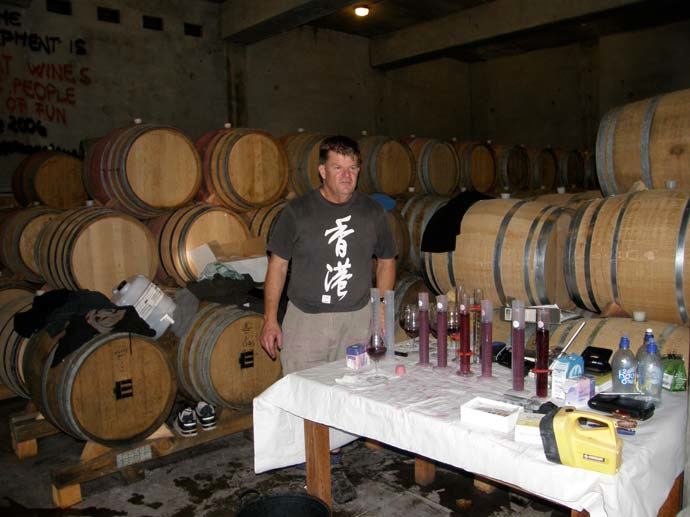
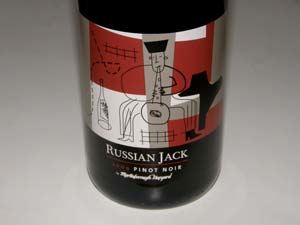 2008 Russian Jack Martinborough New Zealand Pinot Noir 13.9% alc., $18, screw cap. Imported by Sorting Table, LLC, Napa, CA. A second label from Martinborough Vineyards. Named after a famous swagger who helped clear the land. · Moderately deep perfume of black cherries, blackberries and vanilla bean. Tasty core of dark cherries and berries accented with cola and vanilla. A charming middle weight wine with soft tannins and pleasing intensity. Cool package. Good.
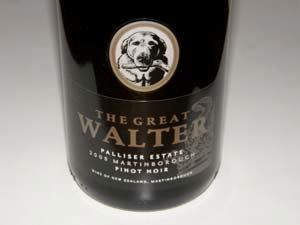 2008 Palliser Estate The Great Walter Martinborough New Zealand Pinot Noir 14.5% alc., $55, screw cap Imported by Negociants USA Inc, Napa, CA. This wine is the fourth in the “Great Dog” series from Pencarrow Vineyard in Martinborough. Clones 667 and 777. Aged 16 months in 66% new French oak barrels. · Moderately dark reddish-purple color in the glass. Shy aromas of dark berry jam and subtle oak. Delicious dark berry core that really attacks the mid palate with a vengeance. Hints of Dr. Pepper and tobacco add interest. Oak has a definite presence but is beautifully married to the fruit. Soft in the mouth, this wine really grows on you over time in the glass. Very good.
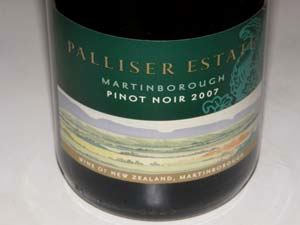 2007 Palliser Estate Martinborough New Zealand Pinot Noir 14.0% alc., $26, screw cap. Imported by Negociants USA Inc, Napa, CA. · Deep reddishpurple color in the glass. Complex aromatic profile featuring dark cherries and berries, savory and oregano spices, ash and oak char. Full-bodied assortment of purple fruits with a hint of pepper and pharmaceutical. Well-structured with firm tannins and a clean finish with a tarry note. Decent.
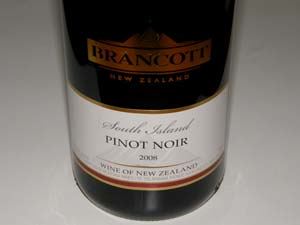 2008 Brancott South Island New Zealand Pinot Noir 13.0% alc., $10, screw cap. Imported by Pernod Ricard USA, Purchase, NY. Sourced from vineyards in Marlborough, Waipara and Central Otago. Produced by the conglomerate, Montana Wines Ltd., in Auckland. · Lighter garnet color in the glass. Attractive scents of wooded cherry, raspberry and summer herbs. Simple and direct flavors of strawberries, cherries, Red Vines, and herbs wrapped in silky tannins. Nothing epiphanic, but varietally true and hard to complain about the ten spot price tag. A good starter Pinot for newbies. Decent.
Marlborough is New Zealand’s largest wine growing region and the center of the New Zealand wine industry. The Marlborough wine region represents 62% of the total vineyard area in the country. It’s reputation was established by Sauvignon Blanc which was first produced here in 1977. Today, the region is widely considered to produce the world’s best Sauvignon Blanc. The most visible winery is internationally famous Cloudy Bay, now owned by the French Champagne house, Veuve Clicquot Ponsardin. In the 1970s, Montana started producing wines which were labelled by vintage and grape variety. The region has fertile soil and temperate weather with warm, sunny days and cool nights allowing for a long growing season. The majority of plantings are around Renwick, Blenheim and Cloudy Bay in the Wairau Valley. Further south in the Awatere Valley are plantings near Seddon on terraces of the Wairau and Awatere rivers.
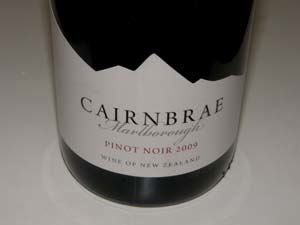 2009 Cairnbrae Marlborough New Zealand Pinot Noir 14.0% alc., pH 3.58, $17, screw cap. Imported by Station Imports, Colorado Springs, COL. Vineyard neighbors the famous Cloudy Bay Vineyard. Winemaker is Christie Brown. · Moderately intense reddish-purple color in the glass. Cherry and red berry aromas with floral and leafy accents. Slightly tart dried cherry and pomegranate flavors with a green leaf note of under ripeness. The very bright acidity on the finish clamors for food. The wine has some delicate charm but the fruit and acidity are not in cinc. Decent.
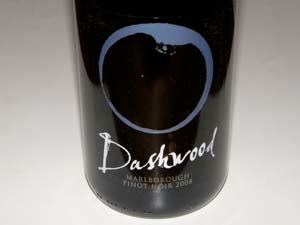 2008 Dashwood Marlborough New Zealand Pinot Noir 13.0% alc., $14, screw cap. Imported by Pasternak Wine Imports, Harrison, NY. From Awatere and Wairau Valley vineyards. Produced by Vavasour Wines Ltd. · Moderate reddish-purple hue in the glass. Fresh aromas of dried red fruits and herbs. Light and simple redder fruits are featured with cherry-red candy flavor prominent. Bright with gossamer tannins making for easy drinkability. Decent.
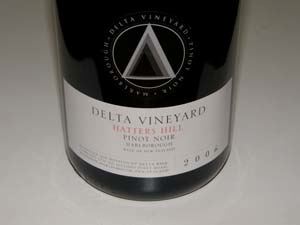 2006 Delta Vineyard Hatters Hill Marlborough New Zealand Pinot Noir 13.0% alc, $23, screw cap. Imported by Vintus LLC, Pleasantville, NY. From Delta Wine Co.. Tom Hatter was a colorful character who lived in rural Marlborough in the early 1900s. The vineyard was named after him. Dijon clones. Winemakers Matt Thomas and David Glege MW partnered to produce this wine. · Dark red cherry and berry aromas with hints of smoky oak, grass and leaf. Discreetly concentrated core of strawberry and raspberry fruit with underpinnings of grass, tobacco and oak enveloped in mildly firm tannins and sporting a bright citrusy finish. Decent.
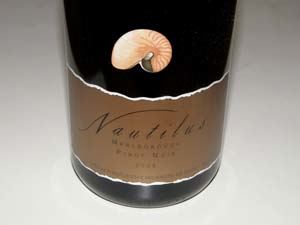 2008 Nautilus Marlborough New Zealand Pinot Noir 14.0% alc., $26, screw cap. Imported by Negociants USA Inc, Napa, CA. 7 day cold soak, aged in French oak barrels. 5 clones from 6 vineyards. · Lovely aromas of dark red cherries, strawberries, raspberries with a complimentary spice note. Highly perfumed right out of the bottle. The flavors echo the aromas with added accents of sassafras and savory herbs. Moderately rich with impressive persistence on the finish which sports some restrained dry tannins. Charming and easy to drink. Still fine the next day from a previously opened and re-corked bottle. Very good (+).
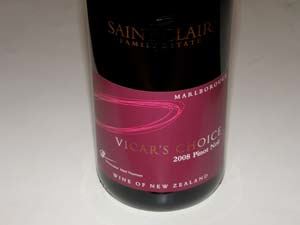 2008 Saint Clair Family Estate Vicar’s Choice Marlborough New Zealand Pinot Noir 13.0% alc., $18, screw cap. Imported by Winesellers Ltd., Skokie, ILL. Owners Neal and Judy Ibbetson, Marlborough pioneers since 1978, have a relative who is a vicar in the Anglican Church and this wine is his choice of barrel samples. The winemaker is Matt Thomson. · Light in color. Savory and fruity nose that appeals with aromas of strawberries, spice and dried herbs. Light on the palate with flavors of red fruits and herbs. Simple, but nicely composed and easy to drink. Good.
2007 Saint Clair Family Estate Omaka Reserve Marlborough New Zealand Pinot Noir 13.0% alc., $28, screw cap. Imported by Winesellers Ltd., Skokie, ILL. · Moderately deep reddish-purple color in the glass. The aromas build in intensity over time in the glass, offering a jolting array of oakkissed and spiced dark fruits. Thick and dense on the palate, with hedonistic liquor-like flavors of blackberries, ollaliberries, and black plums with an earthy underpinning, caressed by downy tannins. The mouth coating sap really makes an impression. A Caliesque style Pinot without the high alcohol. Very good.
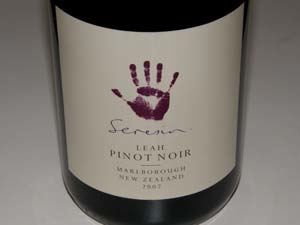 2007 Seresin Estate Leah Marlborough New Zealand Pinot Noir 13.5% alc., $29, screw cap. Imported by The Sorting Table, LLC, Napa, CA. A blend of vineyards. Fermented with wild yeast, aged 11 months in French oak barrels, bottled unfiltered. · Moderately dark reddish-purple robe in the glass. Deep and haunting perfume of black raspberries, cedar, sap, oak and cigar box. Earthy, sweet dark fruit core with added interest from cassis, mushroom, plum sauce and tobacco flavors. Well-muscled with firm tannins which are buffered by bright acidity. Good.
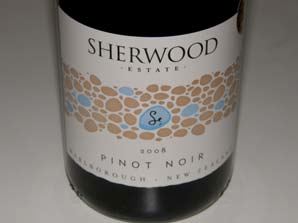 2008 Sherwood Estate Marlborough New Zealand Pinot Noir 12.5% alc., $15, screw cap. Imported bySouthern Starz, Inc., Huntington Beach, CA. Vineyards in Marlborough and Waipara owned by Dayne and Jill Sherwood since 1987. · Shy aromas of red cherries and berries with a leafy accent. Simple and light, with flavors of cherries, strawberries, dried herbs and a hint of oak on the finish. Gossamer tannins make for easy sipping. Decent.
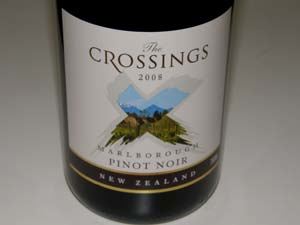 2008 The Crossings Marlborough New Zealand Pinot Noir 13.0% alc., $15, screw cap. Imported by WJ Deutsch & Sons Ltd, Harrison, NY. · A lighter style with soft scents of black cherries, toffee and toasted oak, and diluted flavors of earthy red berries and cherries with oak in the background. Quaffable. Decent.
Nelson Nelson is home to 24 boutique wineries. The vineyards are scattered about the alluvial loam soils of the Waimea Plains and up on the hills of Upper Moutere. The region is situated on the western side of the country near the northern tip of the South Island. Mountains to the west of the region provide a rain shadow effect while the coastline moderates temperature extremes. Nelson receives more rainfall than neighboring Marlborough, but its northern exposure gives it lengthy days of sunshine and the second highest total hours of sun in the country. The Chardonnay and Pinot Noir compete with the best in the country.
2008 Neudorf Tom’s Block Nelson New Zealand Pinot Noir 13.5% alc., 4,080 cases, $30, screw cap. Imported by The Country Vintner Inc., Ashland, VA. Owners Tim and Judy Finn, winemaker John Kavanaugh. Wild yeast fermentation, aged 11 months in French oak barrels, bottled unfined and unfiltered. · Moderately light reddish-purple robe. Very shy redder fruits on the nose with notes of sweet oak and dried apple. Mediumweighted flavors of red berries including cranberry with a hint of spice box. Smoothly textured with dusty tannins. This wine has some charm but at present the flavors trump the aromas. Good.
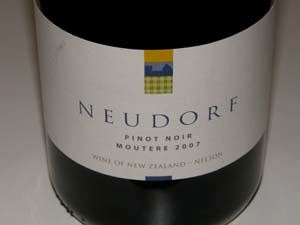 2007 Neudorf Moutere Nelson New Zealand Pinot Noirneud 14.0% alc., 630 cases, $48, screw cap. Imported by The Country Vintner Inc., Ashland, VA. Wild yeast fermentation, aged 11 months in French oak barrels, bottled unfined and unfiltered. · Moderately dark reddish-purple color in the glass. Demure but pleasing aromas of darker cherry and berry fruits including black currants with a subtle underpinning of oak. The dark fruit veers to the ripe side but is very tasty. Seamless with a refreshing acid tang on the finish. Even better the next day from a previously opened and re-corked bottle offering an impressive display of fruit and a peacock finish. Worth a search.
Waipara Waipara is a sub-region of Canterbury, about an hour’s drive north of Christchurch. Canterbury became a focus of attention when the 1984 St. Helena Pinot Noir brought notoriety to the area. Many thought this area might be the anointed home of Pinot Noir in New Zealand and Pinot Noir has become the dominant variety here. Most desirable plantings are on hillsides facing away from the coast. Eastern mountains block out rain from Australia so the region is warm and dry. Pegasus Bay is Waipara’s most noted wine estate, with Pinot Noir vines dating to 1985.
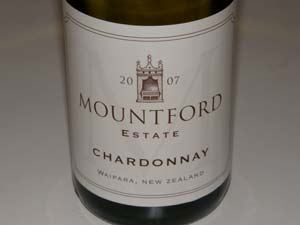 2007 Mountford Estate Waipara New Zealand Chardonnay 14.3% alc., $33, screw cap. Imported by Infinity Imports, Los Angeles, CA. · Straw colored in the glass. Alluring scents of green apple, bergamot, honey and buttered popcorn. Delicious and nuanced with flavors of citrus peel, apple, toffee and allspice. Slightly creamy in texture with bright acidity and a welcoming note of minerality. An impressive wine that supports the notion of many that New Zealand Chardonnay can be striking.
2007 Mountford Estate Liaison Waipara New Zealand Pinot Noir 14.4% alc., $30, screw cap. Imported by Infinity Imports, Los Angeles, CA. Composed of estate and purchased grapes. · Moderate reddish-purple hue in the glass. Lovely perfume of darker fruits with a notable presence of smoky oak. Hearty core of black cherry and ollaliberry with undertones of earth, ash, tobacco and oak char. The flavors have some lingering presence on the finish which is marked by citrus peel. The wine is showing too much oak char at present, but this may well integrate over time. Good.
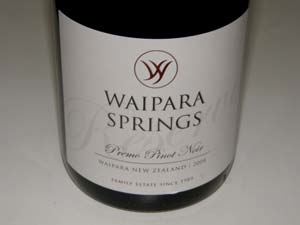 2008 Waipara Springs Premo Reserve Waipara New Zealand Pinot Noir 13.5% alc., $20, screw cap. Imported by Wine Imports LLC, Napa, CA. From the oldest vines in the Waipara Valley. The family estate was established in 1989. 100% de-stemmed, natural yeast fermentation, aged 15 months in French oak barrels. · Very alluring perfume of black cherries, crushed berries, bay leaf and oak toast. Long and complex on the palate with hints of roasted nuts and brown spice augmenting the tasty ripe cherry and berry flavors. Soft in the mouth with refreshing acidity and admirable harmony. Very good.
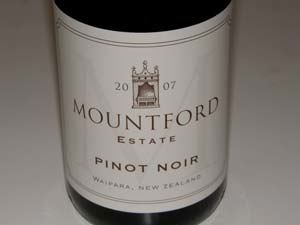 2007 Mountford Estate Waipara New Zealand Pinot Noir 14.3% alc., $42. Imported by Infinity Imports, Los Angeles, CA. Fruit de-stemmed, 1 week cold soak, aged 16 months in French oak barrels with up to 33% new. · Moderate reddish-purple color in the glass. Shy aromas of dark berries and cherries with some smoky oak. Smooth and polished, with focused flavors of black raspberries and black cherries accented with toasted oak and earthy and gamey tones. Like the Liaison bottling, showing plenty of oak at present. Good.
Note: Listen to the recent interview with Mountford Estate winemaker C.P. Lin on Grape Radio at www.graperadio.com/podcast/GR-ENG-USA-2010-11-01.mp3.
Central Otago Central Otago’s viticultural history began with Frenchman John Desire Feraud, who was attracted to the area during the Dunstan gold rush of 1862. He planted the first wine grapes in Central Otago in 1864. Commercial winemaking thrived for twenty years, but when he left the region, the wine industry ceased and wasn’t revived until the plantings farmed by Rolfe Mills in 1975 in the Wanaka area of Central Otago. Mills later planted the Rippon Vineyard in 1982, the first commercial vineyard in Central Otago since the gold rush days. The first commercial release of Pinot Noir from Central Otago was the 1987 vintage from pioneer Alan Brady at Gibbston Valley Winery. Other early pioneering wineries include Taramea, Black Ridge, William Hill and Chard Farm. Felton Road was the first major commercial vineyard and winery in Central Otago. Established in 1991, Felton Road was releasing wines by 1997 that were bringing international attention to Central Otago. Many wineries and extensive plantings, particularly of Pinot Noir, followed. Central Otago is located at 45 to 47 degrees latitude, the same latitude as Burgundy and Oregon’s Willamette Valley in the northern hemisphere. It is the fastest growing wine district in New Zealand. Snow capped mountains are a prominent part of the landscape in winter, but the sun shines brightly during the summer and autumn. Very little rain falls in Central Otago per se, but the surrounding country is quite wet so that water is readily available. The river silts, clays, loams and sands that make up the soils are interspersed with ground schist rocks and are therefore free draining. There is a generous amount of mineral compounds present, but restricted plant growth due to low rainfall has resulted in low organic content in the soil, and the soil is low in vigor. Irrigation is a necessity and is finely tuned to keep the vines at the desired degree of stress.
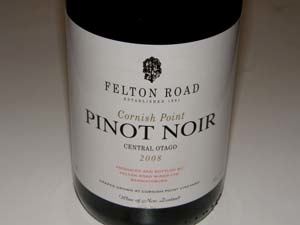 2008 Felton Road Cornish Point Central Otago New Zealand Pinot Noir 14.0% alc., $50, screwcap. Imported by Wilson Daniels, St. Helena, CA. · Moderately dark ruby color in the glass. Haunting perfume of dark stone fruits with hints of oak, compost and pine. Mouth watering and juicy with bright flavors of earth-kissed black cherries, plum sauce, cola, and nutmeg. Well-proportioned tannins and acidity with pleasing persistence of the fruit flavors on the finish. Drinkable now, but can cellar with confidence as it will age effortlessly. The stuff that Pinot dreams are made of.
2008 Felton Road Block 3 Central Otago New Zealand Pinot Noir 14.0% alc., $65, screw cap. Imported by Wilson Daniels, St. Helena, CA. Sourced from Felton Road’s original owner’s (Stewart Elms) first plantings on loamy soil, the so-called “sweet-spot” of the vineyard. · Darkest of the three wines reviewed here. Brooding and tight with a hint of smoky black fruits and toasted oak. Picks up fruit intensity and interest over time in the glass. Moderately dense core of earth-laden black plum and cassis fruit with accents of oak. Grand cru flavor intensity and finish. The tannins are still flamboyant and the wine is reluctant to give up its charm now, but will be great in several years. Still closed the following day from a previously opened and re-corked bottle. Very good.
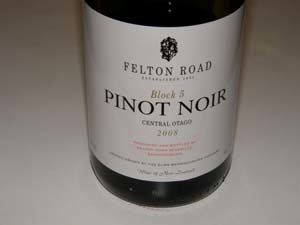 2008 Felton Road Block 5 Central Otago New Zealand Pinot Noir 14.0% alc., $65, screw cap. This block is planted on loam, clay and gravel. · Moderately dark reddish-purple color in the glass. Aggressive aromas of dark Bing cherries, forest floor, spice and pencil lead. Dense and unctuous black cherry core with citrus in the background. Fine-tuned tannins buffer the acidity beautifully. An exceptional wine that is really big and really good, but needs time for full expression. Tasted the next day from a previously opened and re-corked bottle, the fruit was more giving but cellaring is definitely indicated. For grown-ups only.
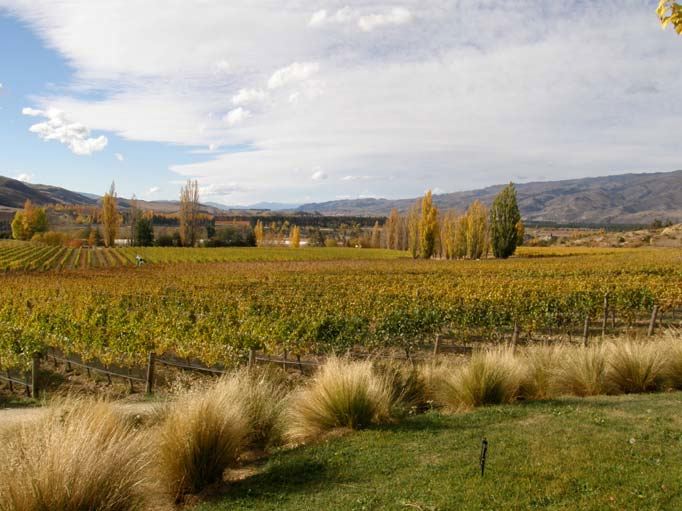
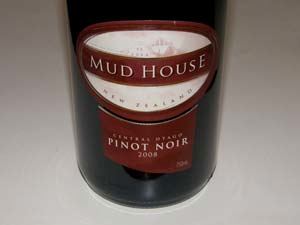 2008 Mud House Central Otago New Zealand Pinot Noir 14.0% alc., $19, screw cap. Imported by Wine Trading Collective, San Francisco, CA. · Moderately light reddish-purple color in the glass. Initially the wine offers bright aromas of strawberries, red cherries and sage, but fades some over time in the glass with toasted oak peeking out. A lighter weighted Pinot that is not much more than pleasant fruit, but is easy to drink. Confected flavors of red cherries, red berries and red hard candy cling to the finish. Decent.
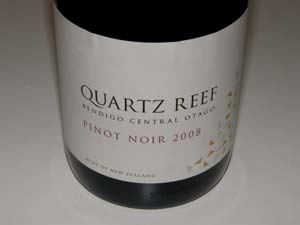 2008 Quartz Reef Bendigo Central Otago New Zealand Pinot Noir 14.5% alc., pH 3.28, $25, screw cap.Imported by Station Imports, Colorado Springs, Colorado. Clones 10/5, 5, 115, 667, 777 and Abel. Aged in 33% new French oak barrels. Gently fined. · Scents of fresh picked berries with plenty of sweet oak. Dark raspberry, blueberry and black cherry fruit is featured wrapped in healthy dry tannins and bright acidity. A vivid and juicy wine that is refreshing to drink and I suspect will improve over time in the bottle. Good.
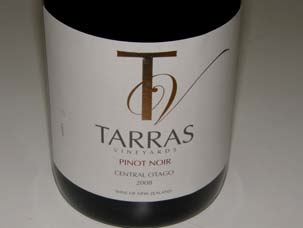 2008 Tarras Vineyards Central Otago New Zealand Pinot Noir 14.5%, $30, screw cap. Imported by Saranty Imports, Harrison, NY. The winery is named after the Central Otago town of Tarras. From The Steppes Vineyard. · Moderate reddish-purple hue in the glass. Attractive aromas of ripe dark fruits. Tasty black cherry and dark red plum fruit with nicely proportioned tannins and acidity and some persistence on the pleasing finish. A nicely composed solid wine. Good.
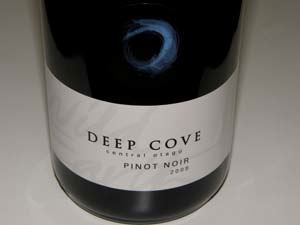 2008 Wild Earth Deep Cove Central Otago New Zealand Pinot Noir 13.8% alc., $19, screw cap. Imported by San Francisco Wine Exchange, San Francisco. Sourced by Bannockburn Estate vineyards owned by the Quider family and other Central Otago vineyards. · Moderate reddish-purple color in the glass. Attractive aromas of strawberry pie, baking spices and balsam. Soft and smooth on the palate, offering a decent core of red berry flavors with a hint of tutti-frutti. This one is simple and direct and goes down easy. Decent.
Carabella: Pinot as it Was Meant to BeThere are many superb producers of Pinot Noir in the Chehalem Mountains. Chehalem (Sha-HAY-lum) is derived from a Native American word, Chahelim, that was the name of a band of Native Americans who lived in this part of the Willamette Valley. The name translates as “gentle place” or “place of flowers.” Dick Erath planted the first vineyards in this region in 1968 on a 49-acre property he bought and named Chehalem Mountain Vineyards. David Adelsheim, Dick Ponzi and others led the second wave in the 1970s. Carabella Vineyard is a more recent addition to the Chehalem Mountains landscape, releasing its first vintage in 1998 from a 27-acre vineyard located on a 58-acre site on the southeastern side of Parrett Mountain, one of the three sub-regions of the Chehalem Mountains appellation. Carabella Vineyard is part of the Inchinnan Farm, a hazelnut orchard still owned by the McDonald family. Carabella’s winemaker is geologist and petroleum engineer Mike Hallock. Trained as a winemaker in Colorado of all places, (the owner of the Combine Cellars in Denver had moved his winery to Colorado to capture an emerging wine market there), he searched for twelve years to find an ideal site for growing grapes before acquiring his site in 1995. He studied the soil types in Oregon and searched for the oldest soils, believing they produced the best wines. Mike and his wife, Cara, partnered with Lake Oswego Mayor Judie Hammerstad and her spouse, John, a retired Oregon University surgeon, to launch the Carabella Vineyard project. For several years Hallock commuted between Denver and Oregon to make Carabella wines, finally moving to the Willamette Valley permanently in 2001. He developed his winemaking skills working alongside Kathy Joseph of Fiddlehead who made wine in Oregon for several years, while taking University of California at Davis classes. Pinot Noir is the main emphasis at Carabella Vineyard with five Pinot Noir clones planted including Pommard, Wädenswil, and Dijon 113, 114 and 115. There are also two blocks of Pinot Gris and two blocks of Dijon 76 Chardonnay. Planting started in 1996 with added vines in 2007. The soils are mainly Nekia and Jory volcanic gravel. The vineyard is farmed sustainably and without irrigation. Currently, Hallock crafts his wines at the 12th & Maple Wine Company custom crush facility in Dundee. About half of the Carabella Vineyard grapes are sold to other wineries, including Daedalus, Owen Roe, Rex Hill and Zelko. Hallock has sought to create Pinot Noirs with finesse and elegance and his 2008 vintage Pinot Noirs are proof that he has achieved his goals. New oak is limited to 33% with the remainder of the aging carried out in second and third year French oak barrels. Hallock’s years of experience with his vineyard is now paying off and his current offerings are Pinot Noir as it was meant to be: aromatic, charming, refined and charismatic. His wines are among the finest I have sampled from Oregon’s superb 2008 vintage. All the wines were released November 1, 2010. The Pinot Noirs are all 100% Pinot Noir.
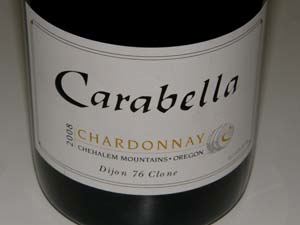 2008 Carabella Dijon 76 Clone Chehalem Mountains Oregon Chardonnay 13.5% alc., 208 cases, $26. · Light straw color in the glass. Lovely scents of green apple, lemon zest, jasmine, vanilla and polished wood. Reserved but pleasing flavors of lemon, papaya, and apple. Fresh and crisp with an underlying minerality unadorned with oak. Hallock takes Chardonnay seriously and it shows. Good.
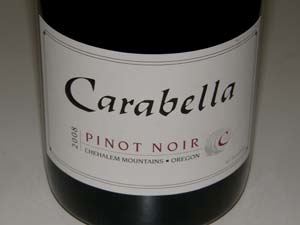 2008 Carabella Chehalem Mountains Oregon Pinot Noir 14.5% alc., 681 cases, $35. This wine is a blend of the entire vineyard. · Knockout fruity nose right out of the bottle redolent with hi-tone spicy plum and berry aromas. Delicious essence of perfectly ripe cherry and berry fruits offered in a moderately rich format supported by fine-grain tannins and complimentary mineral-driven acidity. The wine is smooth and easygoing with beautiful harmony. Still fine the next day from a previously opened and re-corked bottle indicating a respectable longevity. Very good.
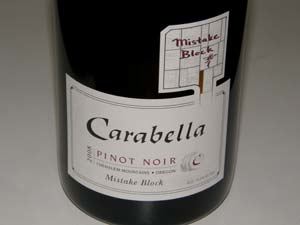 2008 Carabella Mistake Block Chehalem Mountains Oregon Pinot Noir 14.5% alc., 90 cases, $55. In 1998, while planting Dijon 113 vines, some vines were mislabeled resulting in 13 rows of Pommard clone which gave some of the best wine from the vineyard in 2008. · Moderate reddish-purple color in the glass. All the Pinot fruits are represented in the nose with some added floral interest and spice. Very tasty melange of dark red berries, black cherries and plums with an earthy undertone. Constantly intriguing, revealing nuances with every sip. Pleasingly smooth in the mouth with firm but silky tannins. I just love the seamless texture of this wine.
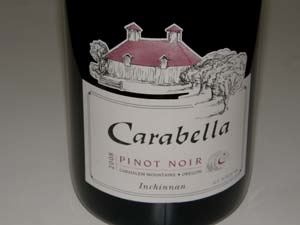 2008 Carabella Inchinnan Chehalem Mountains Oregon Pinot Noir 14.5% alc., 150 cases, $54. 57% Wädenswil plus Dijon 115 and 114. · Moderate reddish-purple hue in the glass. Picks up aromatic intensity in the glass over time offering a plethora of aromas of dark stone fruits, allspice, rose petals, and a hint of cut flowers. Delicious dark plum and blackberry fruit flavors with a bit of sauvage, with eye-opening mid palate intensity, yet still only hinting at its future potential. Very smoothly textured with amazing persistence on the prodigious finish. A benchmark Pinot Noir for Oregon in 2008 that will be nothing short of spectacular in five years.
Carabella wines are sold as futures with futures samples poured on Thanksgiving and Memorial Day weekends. Mailing list members receive futures offers in January. Current releases are available through the website (www.carabellawine.com). The phone is 503-925-0972.
2010 Sonoma County Harvest Fair Wine CompetitionThe 36th annual Sonoma County Harvest Fair Wine Competition was held October 1-3, 2010. 25 respected judges evaluated 1,084 entries. 37 wines were awarded Best of Class Award, 7 wines received a Double Gold Award, and 142 wines a Gold Award. There was no Pinot Noir among the three Sweepstakes winning wines. All the results are viewable at www.harvestfair.org. I have some misgivings about wine competitions, having served as a judge in a few competitions myself. Statistician Robert Hodgson reported research in 2009 that was widely publicized (www.articles.latimes.com/ 2009/sep/04/business/fi-wine4). His findings indicated that repeated judgments of the same wine, by the same expert, are so widely disparate that the ratings and medals given to wines are essentially meaningless. When Hodgson studied the results of multiple wine competitions, he found the medals were spread around at random, essentially what one would expect by chance alone. Some wineries are aware of this and admit sending their wines to many different competitions because the wine, assuming it is good, will eventually win a gold medal by chance if submitted to enough competitions. From a consumer standpoint, the benefits of the results of wine competitions may not have much affect as the results are not widely publicized and a majority of wine consumers pay no attention to medals won, preferring instead to heed the recommendations of wine critics whom they respect. Noted wine writer and critic, Matt Kramer, recently addressed this matter in the Wine Spectator (November 15, 2010). I agree completely with his recommendation to believe in individual tasters. Kramer said, “Never believe a tasting panel. I don’t care who is on it. If what you are seeking is a median mediocrity of taste, then tasting panels are for you.......If you’re going to take advice, which is not a bad idea, then know who you’re getting it from. Because you can’t calibrate your own singular palate against multiple others any more than you can get good direction from five people at once.” I have sat on enough tasting panels to know that the scores given to any wine vary widely among the panel and the best that can be hoped for is a consensus or compromise which essentially says nothing. All that said, I still look at the results of some of the most prestigious wine competitions, but only pay attention to those wines which win major awards such as Sweepstakes, Best of Class, Double Gold or Gold. Below you will find the Pinot Noirs which won Best of Class, Double Gold and Gold at this year’s Sonoma County Harvest Fair Wine Competition. The 25 judges considered approximately 105 wines blind each day in flights of 8 to 14 wines - yikes! I tasted a few of these winners myself after the event to see how my palate matched up. As you can see, the results were varied with some winners failing to draw my high praise. Look for many of these wines at retailer Bottle Barn (also a sponsor of this competition) in Santa Rosa, California.
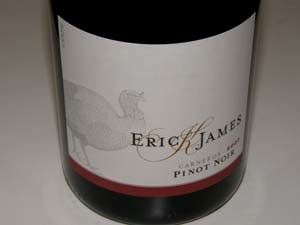 2007 Eric K James Carneros Pinot Noir 14.2% alc., $25 (but available for as little as $18 in the retail marketplace). · Moderate reddish-purple color in the glass. Alluring aromas of dark cherries and berries with hints of mocha, spice and leather. The berry core really grabs on during entry bringing you to attention. Underpinnings of root beer, brown spice and oak add interest. Smoothly textured and easy to drink. This is about as good a value in California Pinot Noir as I have ever tasted. The label sports a turkey making this a perfect wine for an upcoming Thanksgiving dinner. Its darker fruit tones will match well with dark meat and stuffing. The heavy bottle will impress your relatives and they will think you paid a lot more. Very good.
this.fmt_tasting_notes(3742): 3742
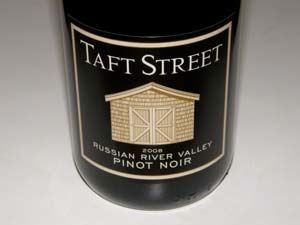 2008 Taft Street Winery Russian River Valley Pinot Noir 14.1% alc., $24 (but available for as little as $16 in retail marketplace). · Moderately intense reddishpurple color in the glass. Uplifting scents of strawberries, red cherries, leaf and smoky oak. Moderately light in weight, with the red berry and cherry core lacking in mid-palate intensity. There is a slight confected note of Red Vines and a subtle undertone of oak char. There is not enough going on in the glass to grab your serious attention, but this is a very serviceable Pinot for the money. Decent.
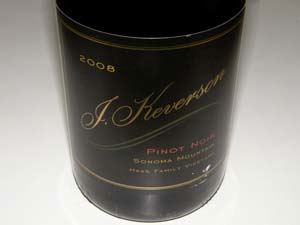 2008 J. Keverson Haas Family Vineyard Sonoma Mountain Pinot Noir 14.9% alc., $32. · Moderate reddish-purple color in the glass. Noticeable legs in the glass due to the high alcohol. A bit shy, put pleasing scents of sweet raspberries, black cherries, biscuit, vanilla and oak. A rich, generous wine with berry, cherry and vanilla cola flavors that explode in the mouth and dance on the finish with tenacity. The tannins are reigned in and the alcohol is well-integrated. This is a Pinot for those who like the rush of busty California fruit. This type of wine shows well in a lineup with other wines at wine competitions. Good.
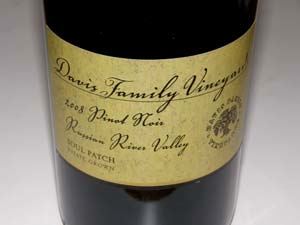 2008 Davis Family Vineyards Soul Patch Russian River Valley Pinot Noir 14.3% alc., $42 (but available for as little as $32 in retail marketplace). Proprietor and winemaker Guy Davis consistently crafts outstanding Pinot Noirs. · Captivating perfume of rich and deep ripe dark berries with a hint of dried rose hips and cut flowers. Mouth coating flavors of fresh picked black raspberries and blackberries that attack the mid palate with a vengeance and persist on the long and lush finish. Striking in its impeccable balance and sexy, silky texture. Class in the glass.
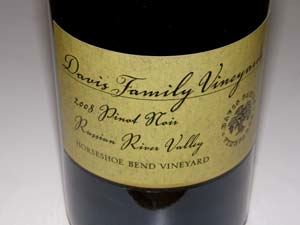 2008 Davis Family Vineyards Horseshoe Bend Vineyard Russian River Valley Pinot Noir 14.7% alc., $42 (but available for as little as $32 in retail marketplace). · This wine pleases with aromas of dark stone fruits, including spiced prunes. Highly enjoyable flavors of dark berries, dark stone fruits, stewed prunes and dark chocolate. Sappier and riper than the Soul Patch bottling, but not jammy, and possessing the same harmony and silky texture. Typical warm weather Pinot. Very good.
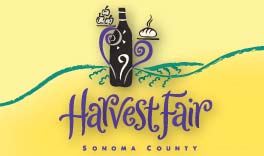
Sips of Pinot
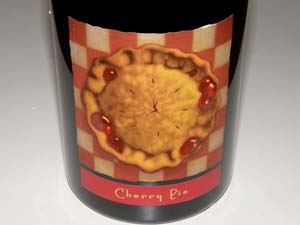 2008 Cherry Pie Stanly Ranch Napa Valley Pinot Noir 14.5% alc., $45. Great label. · Very shy fruit on the nose with prominent scents of oak, pine pitch and varnish. Hearty and full-flavored with copious amounts of black cherry and black raspberry essence set off by brown spice and oak. Generous and fruity rather than classy or complex. The flavors clearly trump the aromas at this stage. Good.
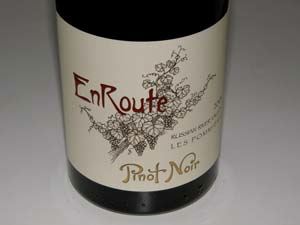 2008 En Route Les Pommiers Russian River Valley Pinot Noir 14.8% alc., $45. Founded by the partners of Far Niente. A blend of Manzana Vineyard and Graton Vineyard in Green Valley and Amber Ridge Vineyard in the Russian River Valley. Clones are Pommard 5, Dijon and heritage. Aged 11 months in 55% new and 45% once-used French oak barrels. · Medium ruby color in the glass. The nose is reluctant initially, offering more charm the following day from a previously opened and re-corked bottle. Aromas of strawberries, cherries, and spice particularly oregano. The kirsch and berry core strikes a chord with its vivid and juicy character accented by notes of baking spices, brioche and smoky oak. Admirable harmony with fine grain dusty tannins and a fruit-filled finish. Not quite up to the excellent 2007 vintage of this wine but solid. Very good.
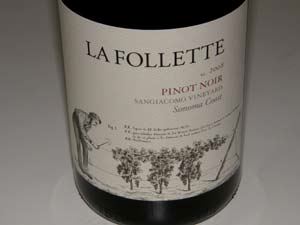 2008 La Follette Sangiacomo Vineyard Sonoma Coast Pinot Noir 14.3% alc., $40. · Moderately intense reddish-purple color in the glass. The nose wants for fruit, featuring instead primarily smoke and ash aromas. Smoky and tarry cherry flavors that are slightly tart and fail to satisfy. A disappointing wine with fruit that never really surfaces and is overshadowed by a brisk acidity. Unsatisfactory.
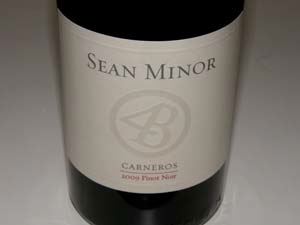 2009 Sean Minor 4 Bears Winery Carneros Pinot Noir 14.5% alc.,pH 3.63, $17 (but available for as little as $13). 100% Pinot Noir and a blend of Pommard and Dijon clones. 100% de-stemmed, coldsoaked for 3 days, aged 9 months in 15% new French oak barrels. · Moderate ruby hue in the glass. Striking perfume of strawberries, raspberries, pear and savory spices. Tasty red, blue and black berry core with a cola and oak note. Quite smooth on the palate and will attract many fans, especially at the low price. A local retailer I know blew out cases of this wine. Will stand up to hearty fare. Very good.
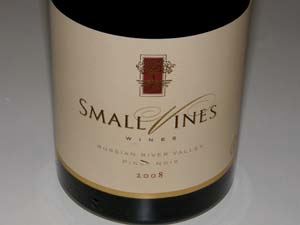 2008 Small Vines Wines Russian River Valley Pinot Noir 14.5% alc., 461 cases, $40. From high-density plantings of 2722 to 3630 vines per acre. Dijon clones 112, 113, 114, 115, 459, 667, 777 and Swan. 6.5% whole cluster, mostly native yeast fermentation, 20 days on skins, mostly native MLF, aged 15 months on fine lees in 39% new French oak barrels, bottled unfined and unfiltered. · Demure lovely scents of Bing cherries and red raspberries with accents of spice box and sweet oak. Vibrant and fresh fruit flavors with an earthy bent, picking up interest and intensity in the glass over time. Nicely balanced t n’a and a suave mouth feel to boot. Quintessential Russian River Valley Pinot. Very good.
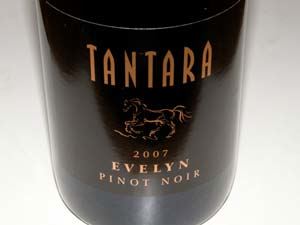 2007 Tantara Evelyn Santa Maria Valley Pinot Noir 14.6% alc., $90. · Dark reddish-purple color in the glass. The nose is darkly fruited with heavy emphasis on oak related scents of smoke and mocha java. Thick and rich on the palate, with a generous offering of dark stone fruits, black cherries, and cassis with underpinnings of coffee and tobacco, all wrapped in soft tannins. Almost syrupy in texture and Schwarzenneggarish in heft. The oak peeks out on the dry finish. Needs time in the cellar to integrate the oak. Good.
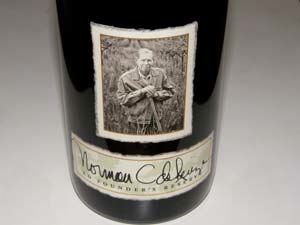 2008 ZD Wines Norman de Leuze Founder’s Reserve Carneros Pinot Noir 14.5% alc., $65. Crafted from organic grapes grown at ZD’s estate vineyard in Carneros. From a 6-acre block planted to the Hanzell clone. Aged 15 months in French oak barrels. · Moderately dark reddish-purple color in the glass. Exotic and well perfumed nose of dark berries, black cherries, tea, wet leaves and floral elements. A rich, big-boned, and dense wine flush with black cherry, blackberry and black plum fruits with a subtle savory herbal note and restrained oak highlights. Very unique and individualistic with a silky smooth texture that attracts another sip. Markedly better the next day from a previously opened and re-corked bottle. I suspect this wine will be remarkable with five years of cellaring. Very good.
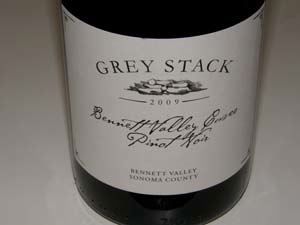 2007 Grey Stack Bennett Valley Cuvée Sonoma County Pinot Noir 14.3% alc., 175 cases, $26. First Bennett Valley cuvée and the first wine from two new sources in the AVA. A blend of three vineyards. Aged 11 months in 50% new French oak barrels and 9 months in bottle. · Shy but alluring melange of berry aromas with a rose petal note. Uniquely flavored core of fresh, juicy wild berries wrapped in fine-grain tannins. The fruits has impressive persistence on the pleasing finish. Really delicious the next day from a previously opened and re-corked bottle. Very good.
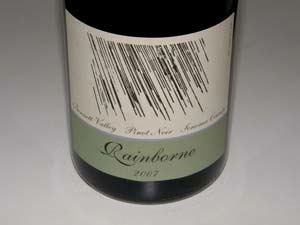 2007 Rainborne Bennett Valley Sonoma County Pinot Noir 14.3% alc., pH 3.65, 228 cases, $38. This winery was founded in 2007 by winemaker Steve Kirby. His background includes a successful career as a classical ballet dancer followed by a degree in enology and viticulture from University of California at Davis and fourteen years of experience crafting wine. All his wines are sourced from dry farmed vineyards because he firmly believes that dry-farmed grapes best show the uniqueness of each individual vintage. Sourced from Blue Moon Vineyard. 10% whole cluster. Natural fermentations. Aged 11 months in French oak barrels. Unfined and unfiltered. · Spend some time with this wine and you will be rewarded. Attractive perfume of sweet-scented oak-tinged dark red berry and Bing cherry fruit. Sleek and refined, with a great backbone of acidity and tannin, this fruity wine lingers with verve on the finish. Over time in the glass, the oak and tannins mellow and the fruit comes to the forefront. Even better the next day from a previously opened and re-corked bottle. A good cellar candidate that will age effortlessly. Very good.
A number of impressive Pinot Noirs have been appearing in the marketplace from Bennett Valley. The appellation consists of only about 700 planted acres, but the wines from this tiny appellation are making an impression on wine aficionados. Matanzas Creek Winery, which released a Bennett Valley Pinot Noir from the 2007 vintage, its first since the 1970s, is the highest-profile producer in this region. Bennett Valley is located at the foot of Sonoma Mountain in Sonoma County approximately four miles from the Russian River Valley. It is Sonoma County's newest appellation, approved in December 2003. The appellation is surrounded by three mountains: Taylor Mountain to the West, Bennett Peak to the East, and Sonoma Mountain to the South (see map below). Most vineyards are planted between 500 and 600 feet elevation and enjoy a consistent marine influence throughout the growing season. The Crane Canyon/Grange Road gap in the mountains allows cooling fog and wind to enter the valley moderating summer temperatures and creating conditions that are ideal for cool climate grape varieties. The soils are mainly rocky and volcanic in origin. The Bennett Valley Grapegrowers Association (www.bvgg.org) lists 31 member growers and 8 wineries scattered among the 8,140 total acres. 66% of the planted acreage is Chardonnay and Merlot, with Pinot Noir only making up 9% of the total. More information on Bennett Valley available on the Grey Stack Cellars website at www.greystackcellars.com.
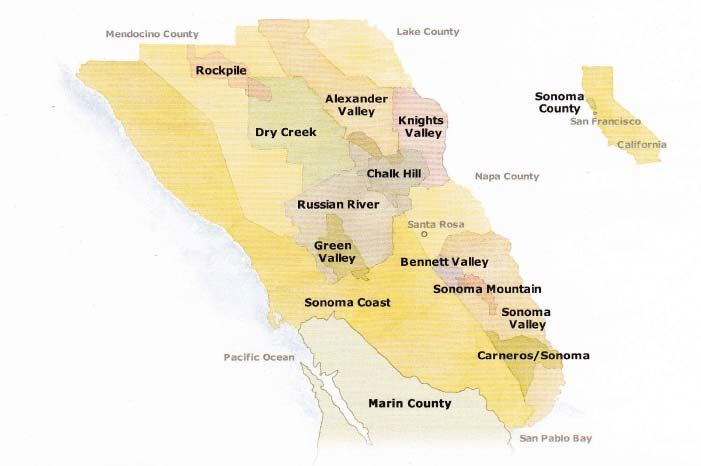
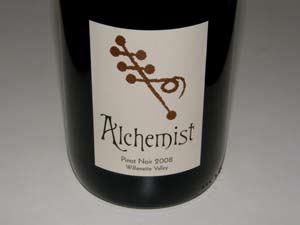 2008 Alchemist Cellars Willamette Valley Pinot Noir 14.1% alc., $25. Sourced from La Colina Vineyard in the Dundee Hills. 18 day fermentation, 20% whole cluster, aged 12 months in 25% new French oak barrels. Produced by Union Wine Company. · Moderately dark reddish-purple color in the glass. Opens reluctantly to reveal lovely scents of fresh berries, sap and old wood. Full-bodied but lithe and silky, with an array of berry, black cherry and cassis fruits touched by oak and accented by an appealing earthiness. Still youthful. Better the next day from a previously opened and re-corked bottle. Very good.
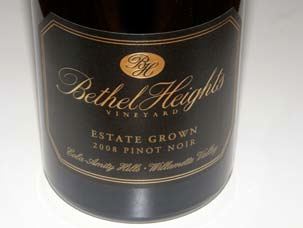 2008 Bethel Heights Vineyard Estate Grown Eola-Amity Hills Willamette Valley Pinot Noir 13.0% alc., $25. An Oregon certified sustainable wine. · Medium reddish-purple hue in the glass. Pleasing aromas of spiced berry compote, chocolate toffee and mocha java. Tasty moderately rich dark berry and plum core with a subtle oak accent of coffee and dried herbs. Enough power to satisfy now, but withholding some of its charms. Better the following day from a previously opened and re-corked bottle indicating further bottle aging will be beneficial. Good.
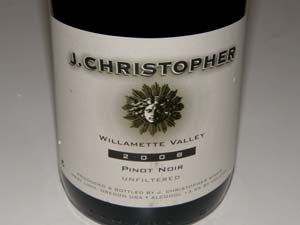 2008 J Christopher Willamette Valley Pinot Noir 13.5% alc., $29. · Aromas of spiced cherries, coffee and oak. Well-oaked red and purple fruits with undertones of tea and mocha. Crisp acidity with notable firm tannins. Drinks better over time in the glass and should improve with time in the cellar. Decent.
2008 Penner-Ash Willamette Valley Pinot Noir 13.5% alc., $32. · Moderately dark ruby color in the glass. A fruity nose redolent with bright dark red berries and cherries with a hint of pine needle and spice. Delicious essence of black raspberries and black cherries enveloped in gossamer tannins. Reasonably pleasing and refreshing although on the lighter side. Beautifully composed with well-integrated oak and a soft, dreamy texture. A straightforward, solid wine that is drinkable now. Good.
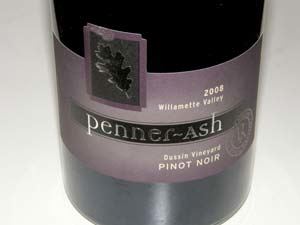 2008 Penner-Ash Dussin Vineyard Willamette Valley Pinot Noir 13.5% alc., $40. From an estate vineyard in the Yamhill-Carlton District planted in volcanic and sedimentary soils. · Darkly colored. Brooding aromas of black fruits with hints of brioche and toasty oak. A polished, refined and sophisticated offering with plenty of earthy black fruits and a healthy tannic backbone. Monolithic and closed now, but gets better over time in the glass. Very soft in the mouth with oak playing a supporting role in the background. Like many 2008 premium wines from Oregon, this one needs a few years in the cellar. Should turn out to be spectacular. Very good.
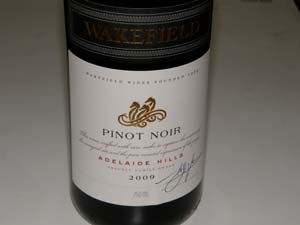 2009 Wakefield Adelaide Hills Australia Pinot Noir 14.0% alc., pH 3.55, $17, screw cap. Imported by American Wine Distributors, South San Francisco, CA. This wine is part of the Estate Series wines. Wakefield was founded by Bill Taylor, Sr., in 1969 along the Wakefield River in the Clare Valley. The fruit is sourced from growers throughout the Adelaide Hills. The fruit was de-stemmed, 60% cold-soaked for 4-6 days, fermented in stainless steel, aged for up to a year in one and two-year-old French oak hogshead barrels. · Moderately dark reddish-purple color in the glass. Aromas of dark fruits, warm walnuts, pine pitch and sweet smoke. Richly endowed with dark stone fruits and plenty of firm tannin balanced by bright acidity. Tasty, but doubt if I would identify this as Pinot Noir if sampled blind. For those looking for something different at a reasonable price. Decent.
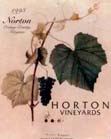 2007 Horton Vineyards The Tower Series Virginia Norton 13.0% alc., $15. I reviewed the excellent book, The Wild Vine, recently (www.princeofpinot.com/article/ 943/), and was finally able to track down a bottle of Norton wine to sample. Norton is a native Virginia grape. Aged 14 months in oak. · Inky purple color in the glass. Aromas of crushed and cooked dark berries, smoke and a chemical note. Feral and peppery black fruits with a pharmaceutical taste in the background and a tangy lift of acid on the dry finish. Well-crafted and possessing an attractively smooth texture. Reminds me of Petite Sirah in heft and size of its tannic backbone. Needs hearty food. An “acquired” taste. Good.
Pinot on the River 2010: Wilted in the RainThere was plenty of disappointment and at this year’s Pinot on the River held at Rodney Strong Vineyards in the Russian River Valley on Sunday, October 24. The region had been deluged with six inches of rain over the weekend and the organizers, Eric Hall and Gregory S. Walter did not have an alternative venue. It was held partially under a tent on a grassy knoll in ankle deep water and mud. I was fortunate to wear some weather boots but some of the women came unprepared and left early. 100 wineries were scheduled according to the program, but several did not show up because of the inclement weather. There was no dollies or assistance for wineries trying to move their wine in the rain from the parking lot to the tasting site which was some distance away. Consumer attendance was noticeably poor giving the impression that the bloom had come off the rose for Pinot Noir. For the $85 admission fee, there were no amenities such as signage to identify where the wineries were located (they were not in alphabetical order), spit buckets, spit cups, bottled water or a place to stash your umbrella. The few food offerings had to be purchased. The program consisted of a single sheet of paper with a list of wineries with nothing more than phone numbers and web addresses and no other information. There was hardly any blank space to record tasting notes. The bright spot at the event was the high quality of the Pinot Noirs offered and the cheerful attitude of the winemakers and winery assistants who weathered the storm so to speak to proudly pour their wines. One person, in particular, stood out for me. Here was Richard Sanford, an icon in the wine business, having traveled over 400 miles, smiling, speaking in his usual soft and pleasing manner, and enthusiastically pouring two of his outstanding 2008 Alma Rosa Pinot Noirs. Many wineries send tasting room assistants or other employees to pour at a lesser event like this. Not Richard. He is a tireless promoter of his wines and manages to appear at practically every Pinot Noir event in California. I have the utmost admiration for him because he is not one to rest on his laurels.

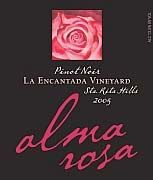 In 2002, a number of events played out that eventually led Richard to loose his namesake Sanford Winery. Undaunted, in 2005, Richard and his wife, Thekla, began a new venture, Alma Rosa Winery and Vineyards. Alma means “soul” in Spanish, reflecting the Sanfords’ view that their wines represent the soul of the Rancho Santa Rosa, the original Mexican land grant on which their vineyards are planted. When Richard left the Sanford Winery, the Sanford & Benedict Vineyard and the La Rinconada Vineyard and winery were relinquished in exchange for the El Jabali Ranch (the site of the Alma Rosa tasting room and Sanford’s personal home) and the La Encantada Vineyard. The Sanfords now organically farm over 100 acres of estate vineyards. There are several Pinot Noirs produced, along with Chardonnay, Pinot Blanc, Pinot Gris and Pinot Noir Vin Gris. The Alma Rosa tasting room is open daily from 11:00 AM to 4:30 PM at 7250 Santa Rosa Road in Buellton. The wines are also sold online at www.almarosawinery.com. There were a number of Pinot Noirs that really stood out for me at this event. My sampling was brief so I do not have extensive tasting notes. However, when wines grab your interest after a brief encounter, they are worth seeking out and spending some time with. Arista 2008 Longbow Russian River Valley Pinot Noir, 2008 Manoni Vineyard Russian River Valley Pinot Noir, and 2008 Toboni Vineyard Russian River Valley Pinot Noir (All are very solid wines and different - Toboni is exceptional). August West 2009 Rosella’s Vineyard Santa Lucia Highlands Pinot Noir and 2009 Graham Vineyard Russian River Valley Pinot Noir ( One of the few wineries pouring the 2009 vintage and these two wines were astonishingly good and surprisingly very approachable now. Winemaker Ed Kurtzman is really on his game in 2009).
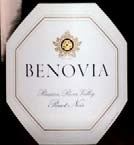 Benovia Winery 2008 Cohn Vineyard Sonoma County Pinot Noir (Planted in 1970, this vineyard outdates most other plantings in the Russian River Valley), and 2008 Le Pommeraie Russian River Valley Pinot Noir (From a Martinelli Family vineyard which was once an apple orchard along the Laguna Ridge - clones 777 and 828 - remarkably intense fruit flavors with bright acidity and certain to be one of my 2010 All Americans). Buena Vista Carneros Winery 2007 Ramal Vineyard Pinot Noir, 2007 Swan Clone Pinot Noir, and 2007 Dijon Clones Pinot Noir (All reviewed previously and still tasting great). Eric Kent 2009 Small Town Sonoma Coast Pinot Noir and 2009 Stiling Vineyard Russian River Valley Pinot Noir (Eric was pouring barrel samples and these were very impressive and rather precocious). Foursight Wines 2009 Estate Anderson Valley Pinot Noir (Several hundred cases of Pinot from 08 were made but severe spring frosts that year caused a 40% loss in crop for that vintage. The wines will be released in 2011. Several lots were not affected buy the wildfires that summer. The 2009 is an excellent followup to their very good 2007 vintage wines). Heart O’ The Mountain 2008 Estate Santa Cruz Mountains Pinot Noir (A great followup to the fine 2007 vintage estate Pinot Noir with more modest alcohol, more complexity).
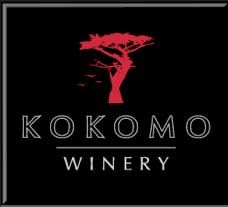 Kokomo 2008 Peters Vineyard Pommard Clone Sonoma Coast Pinot Noir (A beautiful wine crafted in a charming, restrained style but still sporting the earthy, dark fruits of the Pommard clone. Look for my review of this new producer in an upcoming issue). Littorai 2008 Mays Canyon Russian River Valley Pinot Noir, 2008 Platt Vineyard Sonoma Coast Pinot Noir, and 2008 Pivot Vineyard (Estate) Sonoma Coast Pinot Noir (All are exceptional wines with impeccable balance that we have come to expect from Ted Lemon and no signs of smoke taint. The Platt Vineyard bottling is crazy good now). Small Vines 2008 Russian River Valley Pinot Noir and 2008 MK Vineyard Sonoma Coast Pinot Noir (Both are bright, discreetly concentrated, with layers of fruit and interesting aromatic nuances. The MK Vineyard bottling is top shelf).
 Sojourn 2009 Ridgetop Vineyard Sonoma Coast Pinot Noir (I continue to be impressed with the Pinot Noir from Sojourn and this wine, not released yet, was one of the best I sampled at the event). Talisman 2007 Wild Cat Mountain Los Carneros Pinot Noir (Scott Rich crafts interesting, complex and exotic Pinot Noirs from challenging sites that will give those French something to talk about).
Pinot Briefs
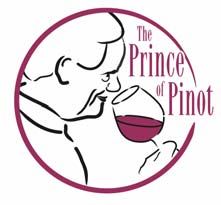 Russian River Valley Immersion Weekend with the Prince Ever wonder what the Prince does on his trips to wine country - where he eats, how he tastes at wineries, what’s it like to get special treatment? I have donated a 4-day extended weekend in the Russian River Valley to ¡Salud! The Oregon Wine Auction November 12-13, 2010. The trip includes a $1000 voucher for airfare, 3 nights at the Benovia Winery 3-bedroom, 2-bath vineyard cottage, hosted lunches at Benovia Winery, Lynmar Winery and J Winery, tours and tastings at top wineries several of which are not open to the public including Kosta Browne, Williams Selyem, du MOL, Littorai, and Freestone Vineyards, dinner wines provided by the Prince from his own cellar, 3 magnums of Russian River Valley Pinot Noir from Kosta Browne, Williams Selyem and Mary Edwards, a first-edition copy of the book Passion for Pinot signed by the author and photographers and nearly 200 winemakers and winery owners, and a copy of the James Beard Award winning DVD, Stewards of the Land, featuring the Russian River Valley. The timing of the trip will be subject to availability of the Benovia lodging and my schedule. You may bid on this oral auction item even if you do not attend the event. Visit www.saluda auction.org for details on how to bid on this item. This Oregon Wine Auction proceeds go towards providing health care for seasonal farm workers in Oregon. As a retired physician, this is a cause close to my heart. Contact me if you have any questions about the weekend trip or how to bid. Sideways Sequel Wine Enthusiast (October 12, 2010, www.winemag.com) reported that writer Rex Pickett has written a sequel to his novel Sideways titled Vertical. The book is self-published and will be available on Amazon.com in November 2010. The novel picks up seven years later with Miles as a successful author with a movie produced from his novel (just like Pickett). Jack is divorced, drinking too much, and is unemployed. Miles’ mother has had a stroke and wants to stay with her sister in Wisconsin. Miles is offered the opportunity to be the Master of Ceremonies at the International Pinot Noir Celebration. The pair hatch a plan to lease a handicapped-equipped van, hire a pot-smoking caretaker, and take off to the Willamette Valley on their way to Wisconsin. The director of Sideways, Alexander Payne, and producer, Michael London, are seriously considering a movie based on Vertical.
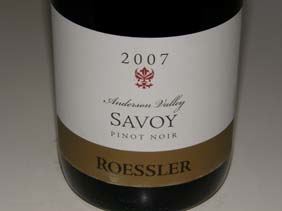 Hall Wines Acquires Majority Interest in Roessler Kathryn and Craig Hall, proprietors of the 35,000 case Hall Wines in Napa Valley, has acquired a large interest in the 7,000 case Roessler Cellars which specializes in Pinot Noir and Chardonnay. Owner Roger Roessler will retain partial ownership and will be involved in the promotion of the label. Roger Roessler, along with his brother Richard, are focusing on their own R2 umbrella of wines including Pinot Noir, Chardonnay and Rhone varieties that are reasonably priced and sourced from Roessler’s estate vineyard, other vineyards and purchased bulk wine. The Roessler wines, which have been produced at Carneros Vintners, will now be made at Hall’s St. Helena winery. The R2 wines will continue to be crafted at Carneros Vintners. A Black Pine Pinot Noir has already been released as part of the R2 lineup. Roessler winemaker Scott Shapely will consult initially with Hall’s winemaker Steve Leveque on the 2010 vintage at Roessler. Latest Figures The Department of Food and Agriculture reports that 90 percent of the wine made in the United States originates in California, which grows 3 million tons of grapes yearly and produces more than 2.5 billion bottles of wine. Washington state is the country’s second biggest producer of wine. California is the fourth leading wine producer in the world behind France, Italy and Spain. Although Napa Valley is regarded as the most well known of California wine making regions, it produces less than 5% of all the wines made in California, but accounts for more than 30% of dollar sales of California wines. There are about 3,000 wineries in California and 4,600 wine-grape growers. More than 117 varieties of wine grapes are grown in California. By volume, Chardonnay is the clear leader, followed by Cabernet Sauvignon, Merlot, White Zinfandel and Sauvignon Blanc. Wine grapes are grown in 48 out of the 58 counties in California. US Monitoring Pinot Noir from the Languedoc The TTB has enacted new restrictions that require importers and wholesalers in the US to obtain a declaration from the French government that the wine has been produced within French appellation rules. The TTB also plans to scrutinize the marketing of mislabeled Pinot Noir in the US. Los Gatos-Saratoga Wine Trail Five historic Santa Cruz Mountains wineries have joined to attract tourists and wine enthusiasts to the Los Gatos-Saratoga region. The Wine Trail is 12 miles in length and includes Fleming Jenkins Vineyards & Winery (owned by Dr. Greg Jenkins and spouse Peggy Fleming, an Olympic Gold Medalist), Testarossa Winery (the oldest continuously operating winery in the San Francisco Bay Area), Cinnabar Winery, Cooper-Garrod Estate Vineyards (owned by former NASA test pilot George Cooper and located in the historic Fruit House that was built in 1922), and Savannah-Chanelle Vineyards (set in a landmark winery among the redwoods overlooking Saratoga village). Visit www.lgswinetrail for information. Too Lazy to Pull Out the Cork? The new Metrokane Electric Rabbit Corkscrew has a recessed spiral that fits neatly over a wine bottle and is compact in design. The illuminated LCD screen shows how many corks you can pull before recharging. Pulls all types of corks, even synthetic plastic ones. Includes a foil cutter and AC charger. No base required for charging. Great Christmas gift. $50. Visit www.metrokane.com for information.
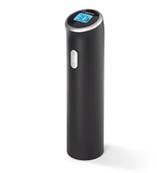 New Pest in Vineyards: Pinot-Loving Baboons A new threat to South African vineyards are groups of wild Cape Baboons which have taken a liking to Pinot Noir and other grapes. Reportedly they prefer Pinot Noir over Merlot and Cabernet Sauvignon. The primates have been driven from their natural habitat by fires and are able to consume up to 1,300 pounds of grapes a day. The problem has been difficult to manage as baboons have protected status. Increasing Cork Closures in the US Premium wineries in the United States are increasingly turning to cork closures according to a survey released in September 2010 by the Cork Quality Counsel and based on data from A.C. Nielsen. Of the top 100 top selling brands priced at over $6, 72 use cork closures, an increase of 7.5 percent during the preceding five months. Cork closures showed an average annual sales increase of 10.2 percent, compared to annual growth of 3.7 percent for alternative closures. “100% Cork,” a campaign to educate U.S. wine consumers about the benefits of cork closures and is funded by the Portuguese Cork Association and the Cork Quality Council, released the sales figures Ravenous Birds Feasting on Pinot Noir in Oregon The late harvest in Oregon has led to an increased threat from flocks of birds, and, according to OregonLive.com, between 5 and 50 percent of growers’ crops will be eaten before harvest ends this year. Ripening was pushed back by two to three weeks by a damp spring and cool summer. Birds include starlings, jays, robins, cedar waxwings and flickers. Deterrents used with mixed effect are propane cannons, automated noise makers, shotguns, field hands banging trash can lids, flashy reflective tape, and of course, netting which is not currently in widespread use in Oregon. Lompoc City Council Approves Tasting Rooms in “Wine Ghetto” The Lompoc City council amending the zoning ordinance and now allow tasting rooms in the Sobhani Industrial Park known affectionately as the Lompoc Wine Ghetto. The 85,000-square-foot industrial park is nearly full now with wineries and tasting rooms including Jalama, Flying Goat, Ampelos Cellars/Chien Wines, Fiddlehead Cellars, La Vie Vineyards, Loring Cellars, New Vineland/Piedrasassi, Nicolaysen Family Vineyard, Palmina, Samsara Wine Co., Zotovich, and the group tasting room known as Taste of Santa Rita Hills. Moderate Drinking Lowers Risk of Sudden Cardiac Death in Women Researchers reported in the journal Heart Rhythm that “light to moderate alcohol intake (one to two alcoholic beverages daily) make be considered part of a healthy lifestyle for overall chronic disease prevention including the prevention of sudden cardiac death.” Women who consumed one to two alcoholic drinks (4 to 8 ounces) a day were also shown to be 60 percent less likely to develop fatal heart disease and had a lower risk of suffering a heart attack. No difference was found among the different types of alcoholic drinks. The researchers noted that the findings may in part reflect a healthy lifestyle that women who drink moderately enjoy and not totally attributable to the benefit of alcohol. Past research has shown that men who drank light to moderate amounts of alcohol also showed the least amount of risk for sudden cardiac death. Tasting 2008 Oregon Pinot Noir Podcast on Grape Radio Join the Grape Radio crew as we taste five top 2008 Oregon Pinot Noirs and discuss the wonderful 2008 vintage for Pinot Noir in Oregon. The program includes 16 questions on Oregon Pinot Noir to test your Noiregon IQ. Visit www.graperadio.com. Small Vines Harvest 2010 Video Check out the video to watch the harvest of high-density Pinot Noir plantings farmed by Small Vines Wines. Owner, farmer and winemaker Paul Sloan stars in this video from the Russian River Valley. If you are in the area, Paul and Kathryn Sloan are having an intimate winemaker dinner for only ten guests on November 18, with a special multi-course meal and a rare tasting of Small Vines Wines library wines at Michelin 2 star restaurant Cyrus in Healdsburg. Visit www.smallvines.com/blog.
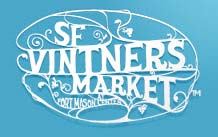 San Francisco Vintners Market - Harvest in the City On Saturday, November 20 and Sunday, November 21 at Fort Mason Center, this event will feature wineries from all over California plus imported wines from around the world. This is the first of its kind wine tasting experience where you can taste wines from over 200 wineries, and buy the wine you like on the spot. Barrel samples and library wines will be available for tasting as well. Admission is $40 in advance ($80 to access reserve wines priced at $50 per bottle and higher). A trade tasting will precede both public tastings. Visit www.sfvintnersmarket.eventbrite.com for information and tickets. Raptor Ridge Winery Opening A new permanent production facility and tasting room has opened in Newberg, Oregon in the Chehalem Mountains. The Raptor Ridge Winery is surrounded by its estate vineyard (18 acres, mostly Pinot Noir) and has breathtaking views of Mount Hood, Adams and St. Helens. Raptor Ridge was founded in 1995 by winemaker Scott Shull, with early vintages crafted in a renovated horse barn next to his home. As the business expanded, wine production was conducted off property at a number of shared winery spaces. The luxury of a permanent winery home has now been realized.The new tasting room at 18700 SW Hillsboro Hwy has an innovative “Apothecary Station,” which allows guests to educate their olfactory senses by sniffing samples of key aromas in wine. Tasting room hours are seasonal with tours available by appointment. The phone is 503-628-8463 and website is www.raptorridgewinery.com.
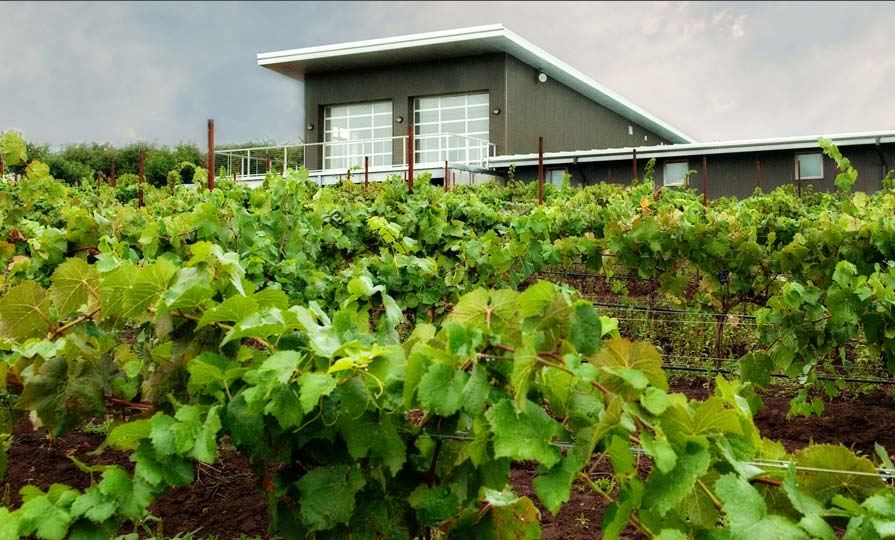
Second Labels Now CommonplaceA trend among Pinot Noir producers, both in the United States and New Zealand, has been to release a second label in the marketplace that takes many forms, but is intended to be a more inexpensive and more accessible bottling that does not detract from the flagship label. These second tier wines may be crafted from declassified juice, unfinished rescued wine on the bulk market, or from grape sources not considered to be prime candidates for the winery’s premium bottlings. Invariably these wines are inferior to the premium primary label wines, but that does not mean the wines do not have a place. They are usually priced below $25, and are solid daily drinkers. Some are very good for the money. They are vinified by the same winery staff, but employ less or no new oak, require less hands-on attention, less aging, and may be blends of different appellations, various vintages or even different varieties of grapes (a wine labeled “Pinot Noir” in the United States only needs to be composed of 75% Pinot Noir). Information about second labels is not always readily available, with many top wineries failing to acknowledge them on their website or marketing materials. Usually one has to look at the back label to find the primary winery name listed after “Produced and bottled by” in tiny print. Some second labels are very secretive and it can be near impossible to track down the primary producer. I have compiled a list of second labels which you can use as a reference. The primary winery name is on the left and the second label is on the right. You may know of others and please let me know and I will add them to the list. Look for these wines to be significantly discounted in the retail marketplace.

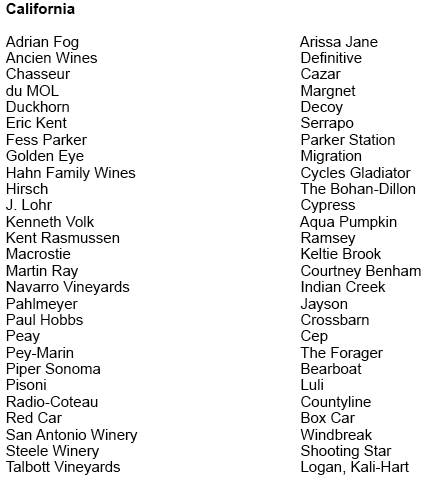
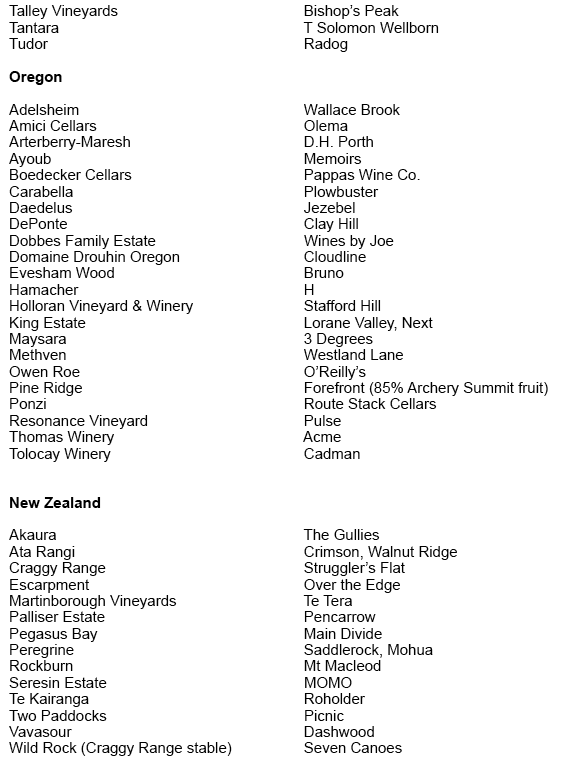 |